
Blancmange is a sweet dessert popular throughout Europe commonly made with milk or cream and sugar, thickened with rice flour, gelatin, corn starch, or Irish moss, and often flavoured with almonds.

Rice pudding is a dish made from rice mixed with water or milk and commonly other ingredients such as sweeteners, spices, flavourings and sometimes eggs.

Coconut jam, also known as kaya jam or simply kaya, is a sweet spread made from a base of coconut milk, eggs, sugar and sometimes pandan leaves as a flavouring. It is popular throughout Southeast Asia.

Haupia is the Hawaiian name for a traditional coconut pudding found throughout Polynesia.
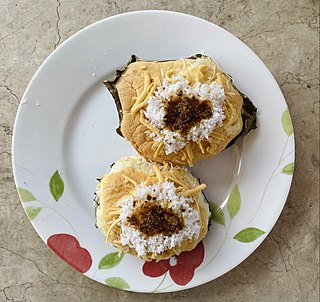
Bibingka is a type of baked rice cake in Filipino cuisine that is cooked in a terracotta oven lined with banana leaves and is usually eaten for breakfast or as merienda, especially during the Christmas season. It is also known as bingka in the Visayas and Mindanao islands.
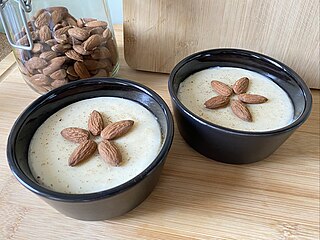
The manjar blanco, known in Catalan as menjar blanc or menjablanc, is a term used in Spanish- and Catalan- speaking areas of the world in reference to a variety of milk-based delicacies. It refers to variations of blancmange, a European delicacy found in various parts of the continent as well as the United Kingdom.

Dominican cuisine is made up of Spanish, Indigenous Taíno, Middle Eastern, and African influences. The most recent influences in Dominican cuisine are from the British West Indies and China.

Kalamay is a sticky sweet delicacy that is popular in many regions of the Philippines. It is made of coconut milk, brown sugar, and ground glutinous rice. It can also be flavored with margarine, peanut butter, or vanilla. Kalamay can be eaten alone, but is usually used as a sweetener for a number of Filipino desserts and beverages. It is related to the Chamorro dessert called kalamai.
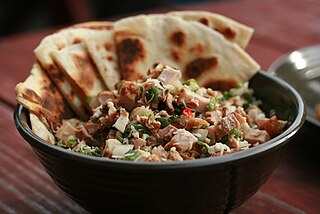
The cuisine of the Mariana Islands is largely made up of meat dishes, including pork, poultry, and meat from other land mammals. Some popular land animals consumed include Mariana fruit bat. Guam and the Northern Marianas split in 1899, when Spain transferred Guam to the United States but the northern islands to Germany, and so there are many similarities, especially the Chamorro food culture.

A great variety of cassava-based dishes are consumed in the regions where cassava is cultivated. Manihot esculenta is a woody shrub of the spurge family, Euphorbiaceae, native to South America, from Brazil, Paraguay and parts of the Andes.

Tembleque is a coconut dessert pudding from Puerto Rico similar to blancmange and related to Latin American manjar blancos and Filipino maja blanca. It is one of the most popular desserts in Puerto Rican cuisine.

Latík refers to two different coconut-based ingredients in Filipino cuisine. In the Visayan region it refers to a syrupy caramelized coconut cream used as a dessert sauce. In the northern Philippines, it refers to solid byproducts of coconut oil production, used as garnishing for a variety of desserts.
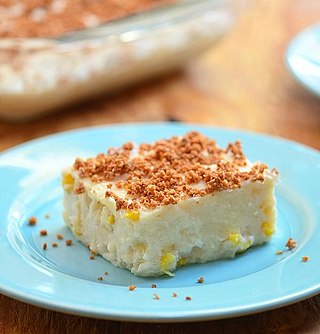
Maja blanca is a Filipino dessert with a gelatin-like consistency made primarily from coconut milk. Also known as coconut pudding, it is usually served during fiestas and during the holidays, especially Christmas.
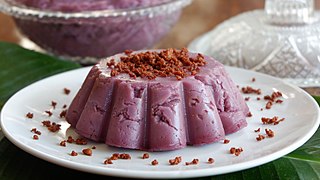
Ube halaya or halayang ube is a Philippine dessert made from boiled and mashed purple yam. Ube halaya is the main base in ube/purple yam flavored-pastries and ube ice cream. It can also be incorporated in other desserts such as halo-halo. It is also commonly anglicized as ube jam, or called by its original native name, nilupak na ube.

Coconut bar is a refrigerated dim sum dessert found in Hong Kong, Taiwan, Southern China and in overseas Chinatowns. It is sweet and has a soft, gelatin-like texture but is white in color rather than translucent like gelatin. It is sometimes referred to as coconut pudding.

Tibok-tibok or carabao-milk pudding is a Pampangan dessert pudding made primarily from carabao milk and ground soaked glutinous rice (galapong). Originating in the Philippine province of Pampanga, it is especially popular in Cagayan. It has a soft jelly-like texture and is topped with latik before serving. It is characteristically creamy white in color and has a delicate, sweet and slightly salty flavor. It is very similar to the more common maja blanca, albeit the latter is made with coconut milk and cornstarch.

Chalakiles is a Chamorro soup from Guam made with chicken, garlic, onion, toasted ground rice, and sometimes coconut milk. Chalakiles can be the entrée or can be served before the main dish. It is considered a comfort food. It is often found at various Chamorro festivities.

















